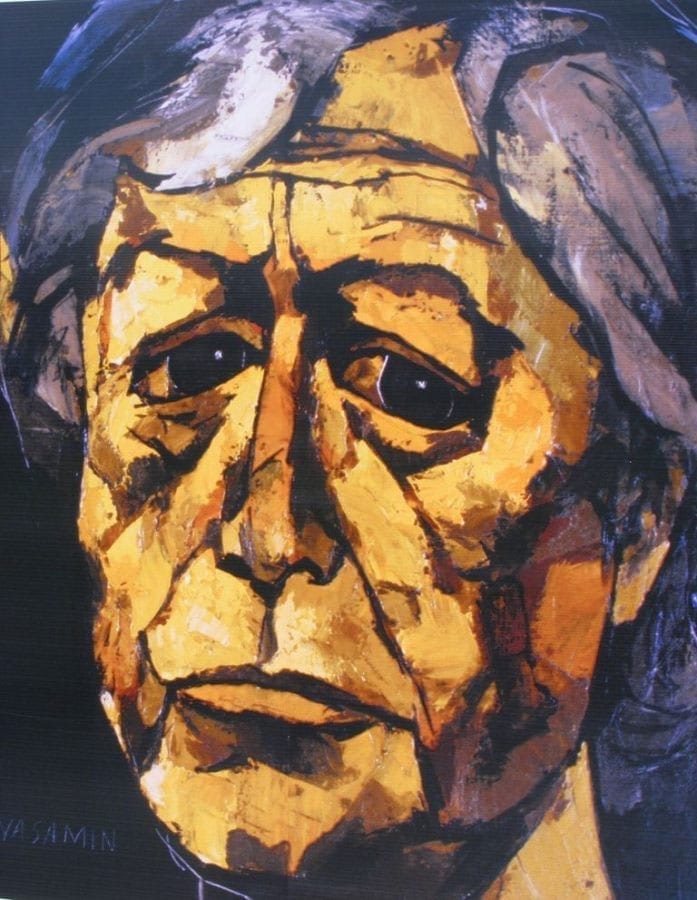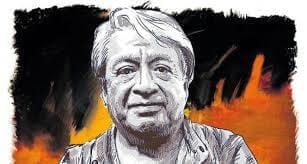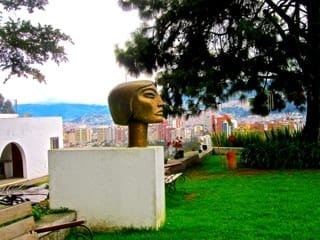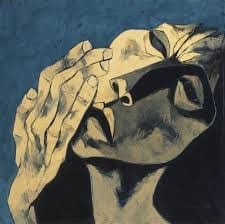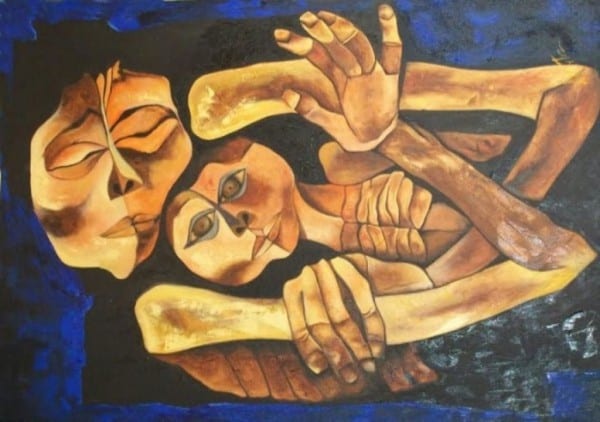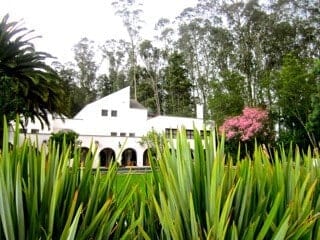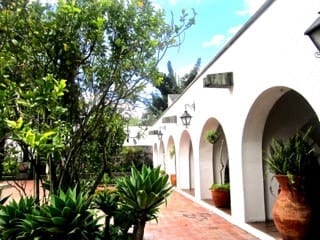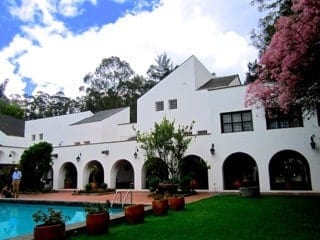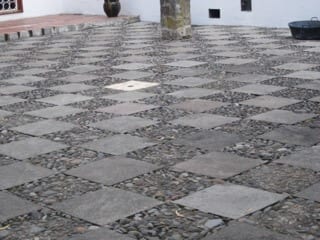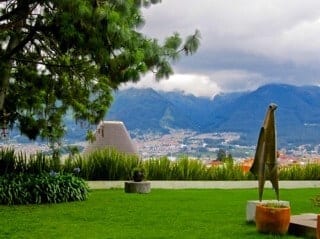CAPILLO del HOMBRE and FUNDACION GUAYASAMIN.
“Don’t leave Quito until you have visited Oswaldo Guayasamin’s Museum and home, ” I was told three weeks into my stay in Quito.
How was it that after three weeks, no one else had mentioned Guayasamin and there was no reference to him in the Guidebooks?
The Museum and Home
Hailing a taxi and handing over my post-it with the name Guayasim Museum and the address, the driver seemed bewildered, and I was no help. We kept stopping to ask people along the way, going further out as the car ascended the narrow streets until we found our way to the main entrance on a hillside on the outskirts of Quito.
First Impressions
As I entered the gate, I noted the expansive view over the valley of Quito and beyond, the setting for these buildings.
In front of me was the Chapel of Man (Capilla del Hombre), the Building that holds a valuable collection of Guayasamin’s most significant artwork.
The Building
The Museum building resembles a huge Inca Temple, and daylight pours in from an opening in the roof. Magnificently displayed inside are enormous paintings, murals and sculptures.
Since it is forbidden to take photographs, I reluctantly obeyed. Joined by an English-speaking guide, we walked and talked throughout the entire Exhibition.
He explained Guayasim’s life and interpreted the artwork. He filled in my incomplete knowledge of the tragic events that had taken place in Latin America, much of which he witnessed. Guayasim recorded and conveyed what he observed in his artistic representations.
The height of the walls were as high as a three-story building and encompassed a huge exhibition hall.
It was a visceral, emotional and gut-wrenching experience witnessing the artwork and what it represented. In no way was I prepared for what I saw.
His early life
Oswaldo Guayasamin was born on July 6th, 1919 to parents of Quechuan (indigenous) descent. The family was poor, and except for the encouragement from his mother, he did not receive any artistic stimulation in the family of ten children. He was the eldest and from a young age, he showed natural talent. He attended and graduated the School of Fine Art in Quito as a painter and sculptor.
He won important International awards and exhibited worldwide from his early thirties and throughout his life. He received an award from UNESCO for “An entire life of work for peace” awarded to him posthumously in 1999.
Enter Rockefeller and a new friend
Nelson Rockefeller had seen some of Guayasamin’s paintings when he visited Ecuador. After purchasing five works, Rockefeller invited him to show his work at a group exhibition at the Museum of Modern Art in New York in the 1940’s.
This is where Guayasamin became friends with Jose Clemente Orozco, a Mexican artist presenting at the same exhibition. They had many common interests and traveled together, to Peru, Brazil, Chile, Argentina, Uruguay and Cuba where Guayasamin met several of the leading politicians of the time.
Orozco was a politically committed artist creating huge murals, representing peasants and workers. Guayasim was also attracted to this genre as he witnessed the upheavals, cruelty, violence, hunger and death in the countries they were visiting.
His Work
At this time, Guayasamin began to paint many of the works displayed in the Chapel of Man. His work at the time included enormous canvases, murals and sculptures depicting the struggles faced by indigenous peoples.
The human figure was presented in exaggerated forms, expressing emotions of grief, loss, pain and anguish.
His canvases show his subjects being tortured, with charred flesh, broken bones, sad faces and desolation, many with imploring, outstretched hands, seeking help that never came.

In addition to what was happening in South America, Guayasim was also very aware of world events, and his art was blatantly honest and truthful. It reflected the injustice, misery and horror of what he saw and is very compelling.
The style is described as Expressionism, but it has strong Latin American characteristics, with dark, heavily saturated colors and black outlines.
Not being familiar with events that took place in Latin America, it was disturbing to me to learn of the crimes against humanity, the suffering, incarceration and violence of this era.
His Home
In total contrast to the Chapel of Man and its dark outer exterior, Guayasamin’s home is painted white. Peaceful and architecturally interesting, it is built on a landscaped plateau, several meters higher than the Chapel of Man that it overlooks.
This is where he worked and lived for the major part of his life after completing his travels with Orozco. Although Guayasamin had studied architecture at the same time as he studied art, it did not form part of his career.
His home, with its perfectly proportioned arches and beautiful interiors was designed by his architect brother, following Guayasamin’s design directions. The house has several rooms, with extensive collections, including outstanding Pre-Colombian artifacts.
The interior of the house is decorated like a living museum with the artist still in residence, his two vintage cars parked undercover and ready. Walking through the house is a welcome relief after experiencing the turbulence of his art in The Chapel of Man.
The Studio is arranged as if still in use, including platforms and ladders used by Guayasamin to complete his enormous works. His easels, paintbrushes and sketches, are displayed as if he were still working.
The bathroom is luxurious and very modern with beautiful fixtures imported from Europe. It is evident he lived a comfortable life surrounded by elegant furniture, beautiful accessories, and worthy collections.
The Exterior
Outside, the landscaping is exceptional. Courtyards are designed with carefully sorted stone laid in geometric designs, with repetitions of arches. Some contain bells suspended in the arc, a strong feature of the design.
There are sweeping, captivating views from the house and terraces over the City and up the side of the mountains, with ever-changing cloud formations.
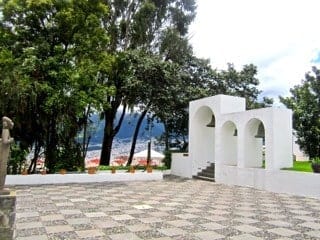
Guayasamin lived out his final days in this beautiful home, intending to complete his masterwork, the Chapel of Man, before his death. Unfortunately, three years before it was completed and opened to the public, he passed away at 80 years old in Baltimore, Maryland, while receiving unsuccessful medical treatment.
Having chosen his final resting place in his garden, his ashes are stored in an urn under a beautiful tree on the lawn in front of the home he loved, overlooking the Chapel of Man and the view of Quito.
In Conclusion
Guayasamin’s home and the Chapel of Man should be near the top of the “List of Things to do in Quito.” Oswaldo Guayasamin is the most important Ecuadorian and Latin American Artist of the 20th Century and is recognized worldwide.
His paintings are a window into the culture, politics and history of his time. These events are recorded through his art, using acute observation and artistic talents aided by his many connections in politics throughout Latin America. He had access to the events as they unfolded. Human pain, suffering, violence and political injustice are universal themes that extend beyond Latin America.
Guayasim was an artist and a humanitarian and absolutely deserving to receive the UNESCO award for “An entire life of work for peace.”
Capillo del Hombre – The Guayasim Museum
- E 18 y
- Sector Mariano Calvache + Lorenzo Chavez
- Quito
- 593-2-244-8492

